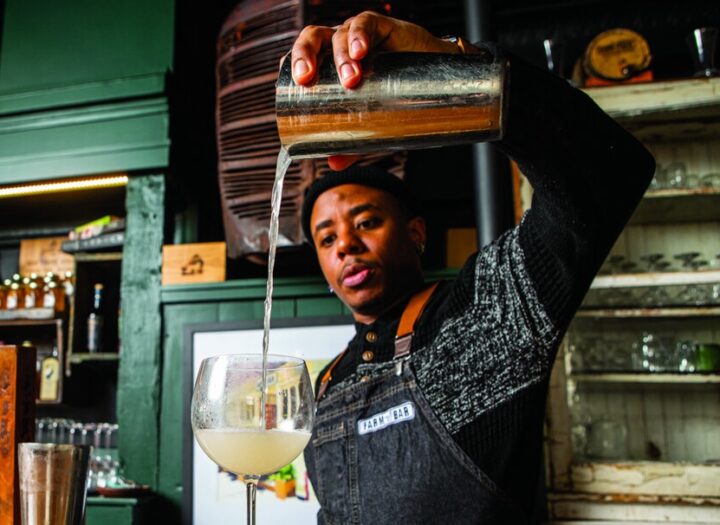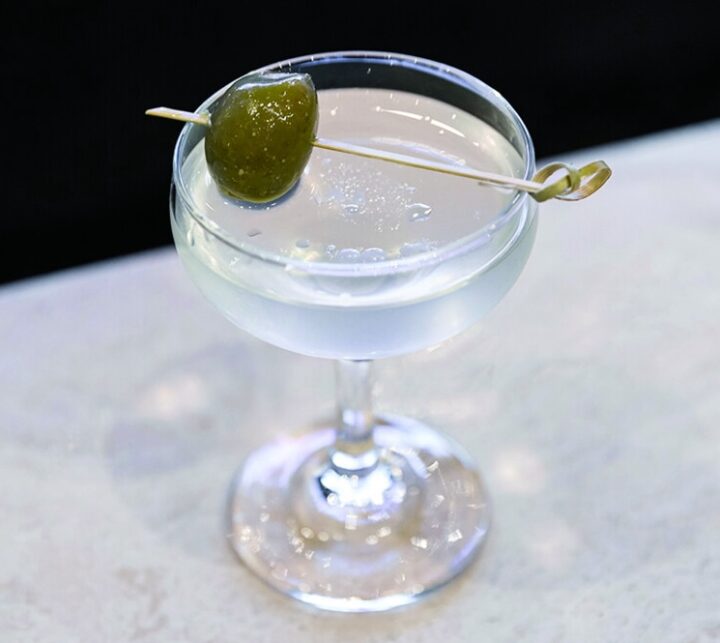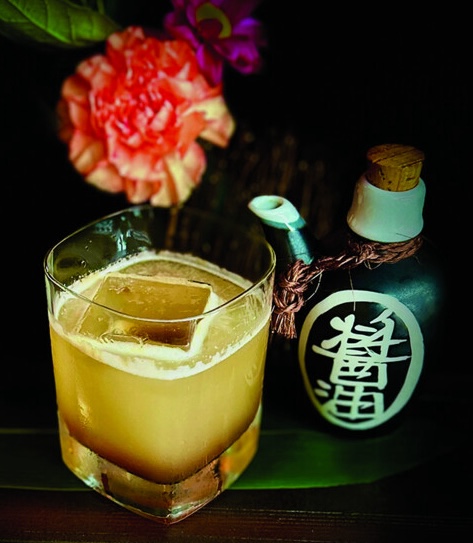
Umami is a complex flavor profile for the American palate, especially in the world of cocktails. While it’s more widely known on a global scale, U.S. drinkers are less familiar with the savory and meaty elements that make up umami, particularly as a drinks ingredient. But many bartenders are adding umami elements to their mixology arsenals these days, experimenting with savory items that are more commonplace on a food menu than a drinks list. And their efforts are being met by a receptive audience of cocktail enthusiasts.
Savvy bartenders know that umami ingredients add balance and contribute to a well-rounded drink, but they’re often underappreciated. “Our palates aren’t trained to associate these flavors with cocktails,” says Justin Young, beverage director at Farm Bar Lakeview in Chicago. Young plays with a variety of umami elements in drinks, including sage, blue cheese, chamoy, bacon, tamarind, basil, and tomato. His Molotov Cocktail ($15) mixes jalapeno-infused Libélula Blanco Tequila and 400 Conejos Espadín Joven mezcal with a house-made tomato-basil Champagne vinegar shrub, lemon juice, celery salt, and soda, while his Dutch Daddy ($15) comprises Famous Grouse blended Scotch, Cynar artichoke liqueur, house-made hickory-infused bitters, sage, and lime.
“Umami profiles hit palate receptors that are more associated with salt or acid, thus adding multiple flavor nuances in one drink,” Young explains. “A common understanding is that umami offers a salty sensation without being salted. On its own, the tomato-basil Champagne vinegar shrub in our Molotov Cocktail leans sweet and sour, but when paired with spicy jalapeño, smoky mezcal, and celery bitters, it transforms the drink into something herbaceous and savory. I often compare umami’s mouthfeel to biting into a Granny Smith apple—imagine that sharp pucker, but instead of tartness you get depth, saltiness, and richness. It’s a starting point for conceptualizing how our taste buds register umami-driven flavors in cocktails.”
Young plans to add another umami drink at Farm Bar Lakeview this summer, as he’s currently experimenting with miso as a fat wash. He says his umami-forward drinks tend to appeal to adventurous consumers. “As we grow older, we naturally move away from sweetness and sugar and more toward savory, but I don’t think we know how to word that aside from ‘I don’t want anything too sweet,’” he says. “People love umami, I just don’t think a lot of people understand it when it’s presented on a [cocktail] menu.”
In Brooklyn, New York, Sungold bar captain Armando Acevedo says guests who are into food, wine, and culinary experiences embrace umami cocktails, while others often need guidance to understand the drink. Sungold, located in the Arlo Williamsburg hotel, regularly features at least one umami-forward cocktail. Currently, the menu highlights the Caprese Martini ($21), made with Ketel One vodka that’s infused sous vide with sweet tomatoes and fresh basil, then clarified with mozzarella and garnished with a blue cheese-stuffed olive. Last year the bar offered a Tequila-based drink called the Black Widow that incorporated squid ink and shilajit.

“There’s a real interest in drinks that are more layered, experiential, and food-friendly,” Acevedo says. “Our Caprese Martini is one of those drinks that makes people pause, take a second sip, and say ‘I wasn’t expecting that’ in a good way. It’s not just a cocktail, it’s like having a salad in a glass. Umami brings depth, roundness, and mid-palate complexity. It softens hard edges, creates a long finish, and encourages slower, more mindful sipping.”
Umami flavors are prevalent in Asian fare, and as such, restaurants specializing in that type of cuisine have an abundance of ingredients to play with in their cocktail programs. Uchi Restaurants, with locations in Texas, Colorado, and Florida, is a prime example. Uchi beverage director Jason Kosmas says umami is a key component of the company’s flavor book for food and drinks, pointing to elements like
mushroom, fish sauce, dashi, soy, and miso. “Umami doesn’t tend to overpower,” Kosmas says. “It enhances, and you feel that in cocktails. Most menus play between sweet, tart, and bitter, but umami adds another dimension.”
Uchi offers the Dirty Dashi Martini made with either Ketel One vodka ($19) or Bombay Sapphire gin ($17) plus shiro dashi and cocktail onions, and the A5 Old Fashioned ($35), blending Suntory AO whisky that’s been fat-washed with Miyazaki A5 wagyu beef and then mixed with Sanonto sugar and meyer lemon. Kosmas is working on additional umami cocktails, including Martinis infused with oyster shells and sea kelp.
“Umami brings joy to your mouth,” Kosmas adds. “It coats it slightly, feels velvety, and lingers on the tongue, adding a long and flavorful finish. Umami-forward drinks usually need a little context. Every menu [in our portfolio] has at least one umami-forward cocktail, and some locations have three or more. It’s a creative space we love exploring.”

Omakase Shoji & Izakaya in Chicago also integrates flavors from its food menu into the cocktail space. General manager Jee Yoon says guests are often curious about what they see on the drinks menu, but also enthusiastic after trying a new umami cocktail. “By integrating subtle touches like soy sauce or seaweed, we evoke a Japanese sensibility that brings richness and nuance to the glass without overwhelming it,” Yoon says. “We aim for simplicity with impact and introduce umami-rich components through carefully crafted infusions, measured additions, or custom syrups. The result is a cocktail that feels intentional, elegant, and distinctly modern.”
The venue’s drinks range from the Soymurai ($18), made with Don Fulano Blanco Tequila, yuzu juice, cucumber simple syrup, and soy sauce, to the Nori Daiquiri ($18), blending nori-infused Diplomático Blanco rum, lime juice, and simple syrup. Yoon says the soy sauce in the Soymurai provides a savory saline finish, while the seaweed infusion in the Daiquiri adds subtle brine and depth to the rum.
“The response has been overwhelmingly positive,” Yoon adds. “Even if a guest isn’t familiar with the term umami, our bartenders guide them through what to expect. Umami lends a subtle savoriness—sometimes described as meaty or brothy—that rounds out acidity and sweetness. It imparts a soft, velvety weight that enhances the overall texture of the drink, making it feel more complete and satisfying. While umami may have roots in Japanese cuisine, its potential in cocktails is universal.”
Consumer education is a critical component to continued success for umami flavors in drinks. At Moody Tongue Sushi in New York City, beverage director Max Stone uses umami flavors in a range of Martinis, including the Everything Bagel Martini, Blue Cheese Olive Martini, and Tomato Martini. The Blue Cheese Olive Martini ($18) comprises blue cheese-infused Haku vodka and Dolin Blanc vermouth, while the Tomato Martini ($18) mixes Haku vodka and Dolin Blanc vermouth with tomato water. Stone says they’re two of the venue’s most popular drinks.
“I think the general public loves umami, but they don’t know that they love umami, necessarily,” Stone adds. “As the public understanding of palate and flavor develops, and culinary knowledge and education [expands], people will continue to refine their desires and be better able to identify the umami they already crave.”
Umami cocktails are also big sellers at La Grande Boucherie, which has locations in New York City, Miami, Chicago, and Washington, D.C. Beverage director David Kravitz says the continuing return of the Dirty Martini, the use of olive and pickle brine, and the always-popular Bloody Mary all contribute to people experimenting more with umami flavors. La Grande Boucherie’s menu lists the Papillon ($18), made with Malfy Gin Con Limone, Rockey’s Botanical liqueur, Dolin Dry vermouth, matcha tea, lemon, and honey, and the Envious Maria, blending El Tequileño Blanco Tequila, Ancho Reyes Verde liqueur, and house-made tomatillo green mix.
“We use umami as we would any other principal flavor,” Kravitz says, noting that the matcha in the Papillon adds viscosity as well as depth. “Sweet, salty, sour, and bitter are all enhanced with umami. The craft cocktail movement has shown people that complex flavors are simply good.”